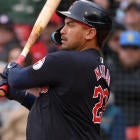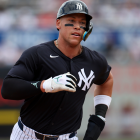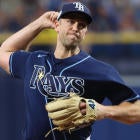Sometimes "different" is bad. Take Kevin Gausman, whose struggles early this season seem tied to his decision to throw his splitter significantly less than he did a year ago.
Sometimes "different" is good, as in Francisco Lindor's early trend toward more flyballs, and the power that comes with it. That's the kind of change you look at and hope to see continue.
And, of course, sometimes "different" is just that. No baseball player is going to be exactly the same every season -- though Nolan Arenado has certainly tried in recent years. Opponents make adjustments to you, and you have to make adjustments right back. That's how you survive in this game.
Let's take a look at five high-profile pitchers besides Gausman who have changed their pitch selection so far, and see what it might mean for their future:
Typically, moving from your four-seam fastball to a sinker generates a tradeoff for pitchers; fewer whiffs, but more groundballs. That has been the case for Noah Syndergaard in his career, but if anyone has room to sacrifice a few swinging strikes in the name of efficiency, it's Syndergaard, who has three of the best secondary offerings in baseball when it comes to generating swinging strikes.
Syndergaard has barely thrown his four-seamer, per PITCHf/x this season, leaning almost exclusively on his sinker. That pitch still comes in at nearly 99 mph on average, and he still generates a healthy number of swinging strikes. However, he has also traded some four-seam fastballs for some changeups, a change it's hard to argue with given his career 21.7 swing-and-miss rate with that pitch.
In truth, it's hard to argue with Syndergaard throwing any of his pitches in any combination, given how good all of them are:
Noah Syndergaard's percentile rank in whiff rate, by pitch:
— Chris Towers (@CTowersCBS) March 16, 2017
Fastball: 90th
Curveball: 82nd
Slider: 99th
Changeup: 83rd
It's not like the 99 mph fastball is all Syndergaard has. Nor is the 91 mph changeup, the 93 mph slider, or the 85 mph curveball really going to lead to an easy time for batters anyway. He's not Clayton Kershaw, but when Thor is on, he's as close as anyone in the majors can get. And this season, with a groundball rate inching close to 60 percent, he might be able to push Kershaw. Just maybe.
Something we'll see a few times in this is a player starting to ditch a fastball as it loses effectiveness. This is something you see with nearly all pitchers as they age and lose velocity, however it's a surprise to see from a player like Dylan Bundy, who is still very much on the right side of 30. Heck, he's on the right side of 25, and yet his average fastball velocity is down more than 2.5 MPH in the early going this season.
Given Bundy's history of elbow injuries, that's certainly something to keep an eye on, though it isn't necessarily a cause for concern yet. He has lost velocity on his fastball, and his whiff rate is down with the pitch as well, but you can live with those results when Bundy has pulled an incredibly effective slider out of nowhere.
After not throwing the pitch for a few years due to concerns about the strain it put on his elbow, but he reintroduced the pitch this spring, and it has fueled everything good about Duffy's season so far. His swinging strike rate with the pitch is a whopping 30.8 percent, making up for middling early numbers with the rest of his offerings. We'll see if this is a sustainable model -- the drop in velocity has to be a concern for a pitcher with Bundy's history -- but for right now, there's a lot to like about the way he's pitching.
Chris Sale is another pitcher who is relying on the fastball less in the early going. After throwing either a four-seam fastball or a sinker 60.9 percent of the time last season, Sale has dropped that number to 47.9 so far, with the difference mostly split between his slider and changeup.
Sale hasn't necessarily lost any effectiveness with his heater, mind you. He still routinely hits the high-90's with it, while racking up a healthy 10 percent swinging strike rate with the four-seamer. However, he has historically picked up swinging strike rates in the 20 percent range with his secondary offerings, so it should be little surprise that he is sporting a career-best 15.8 percent swinging strike rate overall, in light of these changes.
We've seen Sale succeed as more of a pitch-to-contact type last season, but he is at his best when he is mowing down batters with strikeouts, so this is a nice thing to see. A nice bonus? Sale's average fastball velocity is up more than a mile per hour since last April.
Danny Salazar is just impossible to figure out. Catch him on the right day, and he looks like he belongs in the discussion for best pitcher in baseball. However, he hasn't been at his best often enough to be much more than just "pretty good" over his time as a starter in the majors. There's no doubting his stuff, as his 16.7 percent swinging strike rate shows, and he can get swinging strikes with anything he throws.
The trick is finding the right mix of pitches and the consistency needed to live up to his potential, and this change is an interesting one. His changeup has historically been Salazar's best pitch, with a .169 batting average and .089 ISO allowed against it. It's a devastating pitch, one he could conceivably throw as his go-to pitch; he did it against the White Sox on April 12, and had arguably his best outing of the season. Either way, it's hard to argue that more changeups are anything but a good thing for this tantalizingly talented pitcher.
Last week, I wrote that Danny Duffy is the most interesting pitcher in baseball these days, and you should go read that now. He, like Bundy, has seen a dip in his average fastball velocity whether you compare him to all of 2016 or just his time as a starter. He isn't far off where he was back in 2014 and 2015, but seeing as how his breakout in 2016 coincided with an improved fastball, it's fair to be concerned about what his diminished velocity might mean moving forward.
However, as we often see with pitchers as they age, Duffy has begun relying on his secondary pitches more as he has lost life on his fastball. He hasn't dramatically increased either his changeup or slider usage, instead mostly splitting the difference between the two. Considering he did a better job racking up whiffs and limiting hits and extra-bases with his two secondaries than his fastballs, that's not necessarily a bad sign.
Duffy does probably have to be more careful about throwing his fastball, because more exposure could lead to it becoming a real issue for him. However, this is what pitching is. Everyone loses heat off their fastball as they age, and at 28, Duffy is not as young as he might seem. The pitchers who learn to rely on their secondary pitches more are the ones who survive deeper into their careers, and we might be seeing that, at the adapt-or-die portion of his career, Duffy is instead figuring out how to thrive.



























